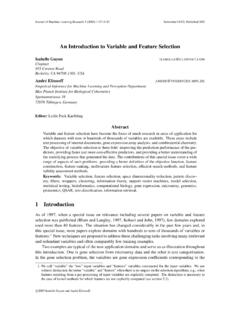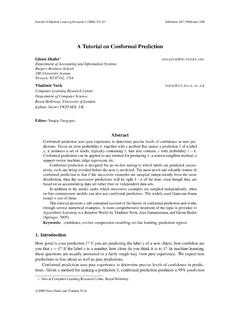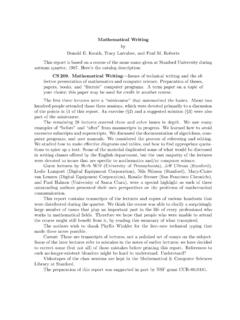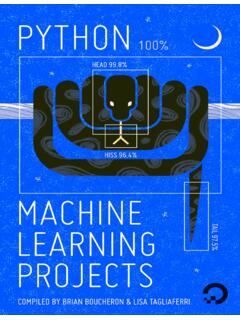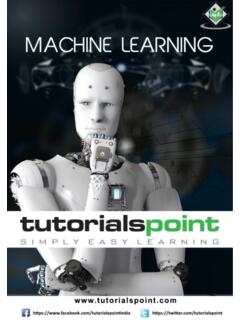Transcription of Scikit-learn: Machine Learning in Python
1 Journal of Machine Learning Research 12 (2011) 2825-2830 Submitted 3/11; Revised 8/11; Published 10/11 scikit - learn : Machine Learning in PythonFabian el INRIA SaclayNeurospin, B at 145, CEA Saclay91191 Gif sur Yvette FranceOlivier rue Soleillet75 020 Paris FranceMathieu University1-1 Rokkodai, NadaKobe 657-8501 JapanPeter at WeimarBauhausstr. 1199421 Weimar GermanyRon Inc76 Ninth AvenueNew York, NY 10011 USAV incent Universit e, IFMA, EA 3867, LaMIBP 10448, 63000 Clermont-Ferrand FranceJake DepartmentUniversity of Washington, Box 351580 Seattle, WA 98195 USAA lexandre LabUMass AmherstAmherst MA 01002 USAD avid Thompson AvenueCambridge, CB3 0FA UKc 2011 Fabian Pedregosa, Ga el Varoquaux, Alexandre Gramfort, Vincent Michel, BertrandThirion, Olivier Grisel, Mathieu Blondel,Peter Prettenhofer, Ron Weiss, Vincent Dubourg, Jake Vanderplas, Alexandre Passos, David Cournapeau, Matthieu Brucher,Matthieu Perrot and Edouard DuchesnayPEDREGOSA, VAROQUAUX, GRAMFORT ET SA, CSTJF avenue Larribau64000 Pau FranceMatthieu Edouard B at 145, CEA Saclay91191 Gif sur Yvette FranceEditor.
2 Mikio BraunAbstractScikit-learnis a Python module integrating a wide range of state-of-the-art Machine Learning algo-rithms for medium-scale supervised and unsupervised problems. This package focuses on bring-ing Machine Learning to non-specialists using a general-purpose high-level language. Emphasis isput on ease of use, performance, documentation, and API consistency. It has minimal dependen-cies and is distributed under the simplified BSD license, encouraging its use in both academicand commercial settings. Source code, binaries, and documentation can be downloaded : Python , supervised Learning , unsupervised Learning , model selection1. IntroductionThe Python programming language is establishing itself as one of the most popular languages forscientific computing. Thanks to its high-level interactive nature and its maturingecosystem of sci-entific libraries, it is an appealing choice for algorithmic development and exploratory data analysis(Dubois, 2007; Milmann and Avaizis, 2011).
3 Yet, as a general-purposelanguage, it is increasinglyused not only in academic settings but also in this rich environment to provide state-of-the-art implementationsof manywell known Machine Learning algorithms, while maintaining an easy-to-use interface tightly inte-grated with the Python language. This answers the growing need for statistical data analysis bynon-specialists in the software and web industries, as well as in fields outside of computer-science,such as biology or from other Machine Learning toolboxes in Pythonfor various reasons:i)it is distributed under the BSD licenseii)it incorporates compiled code forefficiency, unlike MDP (Zito et al., 2008) and pybrain (Schaul et al., 2010),iii)it depends only onnumpy and scipy to facilitate easy distribution, unlike pymvpa (Hanke et al., 2009) that has optionaldependencies such as R and shogun, andiv)it focuses on imperative programming, unlike pybrainwhich uses a data-flow framework.
4 While the package is mostly written in Python , it incorporatesthe C++ libraries LibSVM (Chang and Lin, 2001) and LibLinear (Fan et al.,2008) that provide ref-erence implementations of SVMs and generalized linear models with compatible licenses. Binarypackages are available on a rich set of platforms including Windows and any POSIX : MACHINELEARNING INPYTHONF urthermore, thanks to its liberal license, it has been widely distributed as part of major free soft-ware distributions such as Ubuntu, Debian, Mandriva, NetBSD and Macports and in commercialdistributions such as the Enthought Python Distribution .2. Project VisionCode than providing as many features as possible, the project s goal has been toprovide solid implementations. Code quality is ensured with unit tests as of release , testcoverage is 81% and the use of static analysis tools such aspyflakesandpep8. Finally, westrive to use consistent naming for the functions and parameters used throughout a strict adherenceto the Python coding guidelines and numpy style of the Python ecosystem is licensed with non-copyleft licenses.
5 Whilesuchpolicy is beneficial for adoption of these tools by commercial projects, it does impose some restric-tions: we are unable to use some existing scientific code, such as the design and lower the barrier of entry, we avoid framework code and keep thenumber of different objects to a minimum, relying on numpy arrays for data base our development on collaborative tools such as git, githuband public mailing lists. External contributions are welcome and scikit -learnprovides a 300 page user guide including narrative documentation,class references, a tutorial, installation instructions, as well as more than 60examples, some fea-turing real-world applications. We try to minimize the use of Machine - Learning jargon, while main-taining precision with regards to the algorithms Underlying TechnologiesNumpy:the base data structure used for data and model parameters. Input data ispresented asnumpy arrays, thus integrating seamlessly with other scientific Python libraries.
6 Numpy s view-based memory model limits copies, even when binding with compiled code (Van derWalt et al.,2011). It also provides basic arithmetic :efficient algorithms for linear algebra, sparse matrix representation, special functions andbasic statistical bindings for many Fortran-based standard numerical packages,such as LAPACK. This is important for ease of installation and portability, as providing librariesaround Fortran code can prove challenging on various :a language for combining C in Python . Cython makes it easy to reach the performanceof compiled languages with Python -like syntax and high-level operations. It is also used to bindcompiled libraries, eliminating the boilerplate code of Python /C Code DesignObjects specified by interface, not by facilitate the use of external objects withscikit- learn , inheritance is not enforced; instead, code conventions provide a consistent central object is anestimator, that implements afitmethod, accepting as arguments an inputdata array and, optionally, an array of labels for supervised estimators, such asSVM classifiers, can implement apredictmethod.
7 Some estimators, that we calltransformers,for example, PCA, implement atransformmethod, returning modified input data. Estimators2827 PEDREGOSA, VAROQUAUX, GRAMFORT ET Vector (LARS) (9 components) (9 clusters) : Not implemented. : Does not converge within 1 1: Time in seconds on the Madelon data set for various Machine Learning libraries exposedin Python : MLPy (Albanese et al., 2008), PyBrain (Schaul et al., 2010), pymvpa (Hankeet al., 2009), MDP (Zito et al., 2008) and Shogun (Sonnenburg et al., 2010). For morebenchmarks also provide ascoremethod, which is an increasing evaluation of goodness of fit: a log-likelihood, or a negated loss function. The other important object is thecross-validation iterator,which provides pairs of train and test indices to split input data, for exampleK-fold, leave one out,or stratified selection. scikit -learncan evaluate an estimator s performance or select parameters usingcross-validation, optionally distributing the computation to several cores.
8 This is accomplished bywrapping an estimator in aGridSearchCVobject, where the CV stands for cross-validated .During the call tofit, it selects the parameters on a specified parameter grid, maximizing a score(thescoremethod of the underlying estimator).predict,score, ortransformare then delegatedto the tuned estimator. This object can therefore be used transparently as any other estimator. Crossvalidation can be made more efficient for certain estimators by exploiting specific properties, suchas warm restarts or regularization paths (Friedman et al., 2010). This is supported through specialobjects, such as theLassoCV. Finally, aPipelineobject can combine severaltransformersandan estimator to create a combined estimator to, for example, apply dimension reduction beforefitting. It behaves as a standard estimator, andGridSearchCVtherefore tune the parameters of High-level yet Efficient: Some Trade OffsWhilescikit-learnfocuses on ease of use, and is mostly written in a high level language, carehasbeen taken to maximize computational efficiency.
9 In Table 1, we compare computation time for afew algorithms implemented in the major Machine Learning toolkits accessible in usethe Madelon data set (Guyon et al., 2004), 4400 instances and 500 attributes, The data set is quitelarge, but small enough for most algorithms to all of the packages compared call libsvm in the background, the performance ofscikit-learncan be explained by two factors. First, our bindings avoid memory copies andhave up to40% less overhead than the original libsvm Python bindings. Second, we patch libsvm to improveefficiency on dense data, use a smaller memory footprint, and better use memory alignment andpipelining capabilities of modern processors. This patched version also provides unique features,such as setting weights for individual : MACHINELEARNING refining the residuals instead of recomputing them gives performance gains of2 10 times over the reference R implementation (Hastie and Efron, 2004).
10 Pymvpauses this imple-mentation via the Rpy R bindings and pays a heavy price to memory benchmarked thescikit-learncoordinate descent implementations of Elastic Net. Itachieves the same order of performance as the highly optimized Fortran versionglmnet(Friedmanet al., 2010) on medium-scale problems, but performance on very large problems is limited sincewe do not use the KKT conditions to define an active k-nearest neighbors classifier implementation constructs a ball tree (Omohundro, 1989)of the samples, but uses a more efficient brute force search in large medium to large data sets, scikit -learnprovides an implementation of a truncated PCAbased on random projections (Rokhlin et al., 2009).k-means. scikit - learn s k-means algorithm is implemented in pure Python . Its performance is lim-ited by the fact that numpy s array operations take multiple passes over ConclusionScikit-learnexposes a wide variety of Machine Learning algorithms, both supervised andunsuper-vised, using a consistent, task-oriented interface, thus enabling easy comparison of methods for agiven application.
